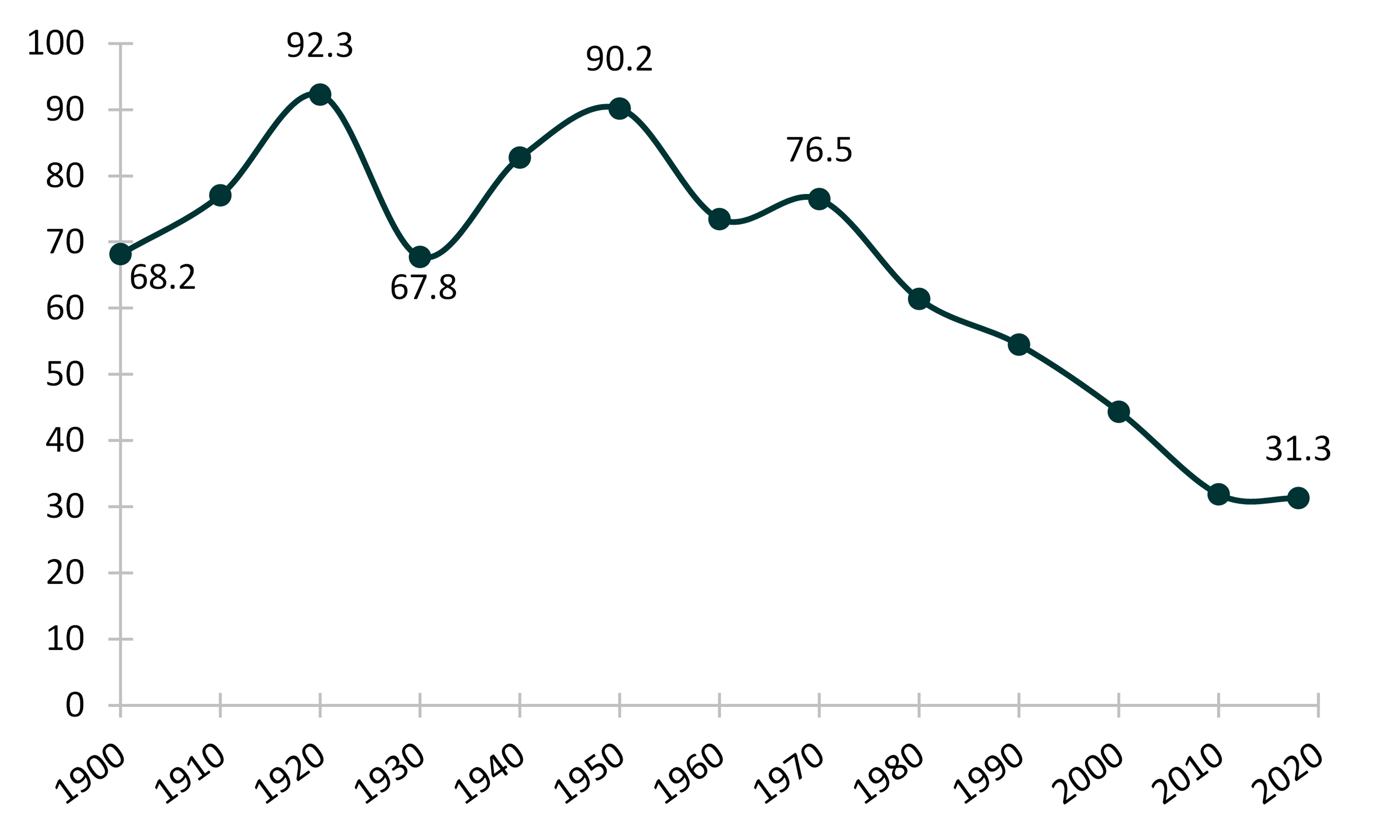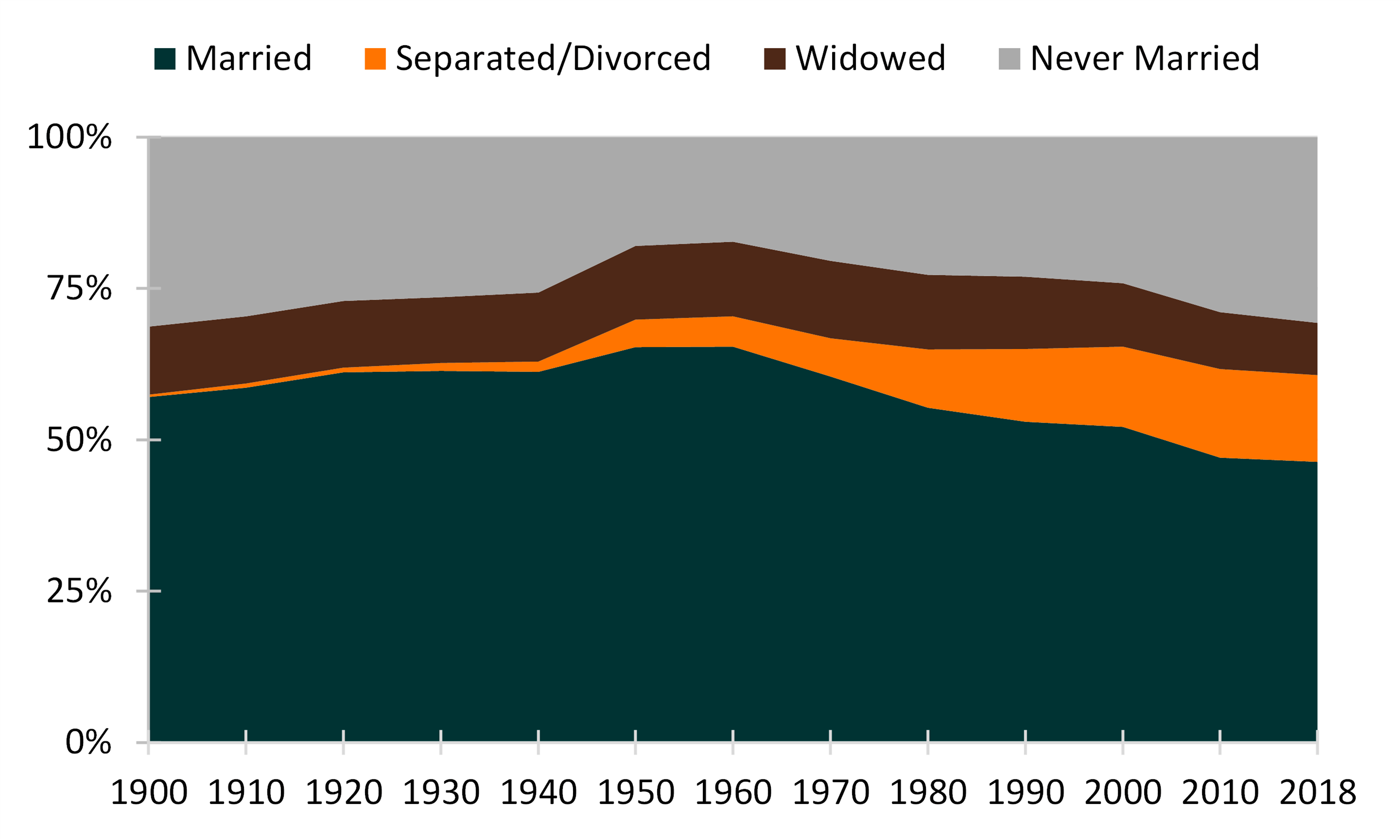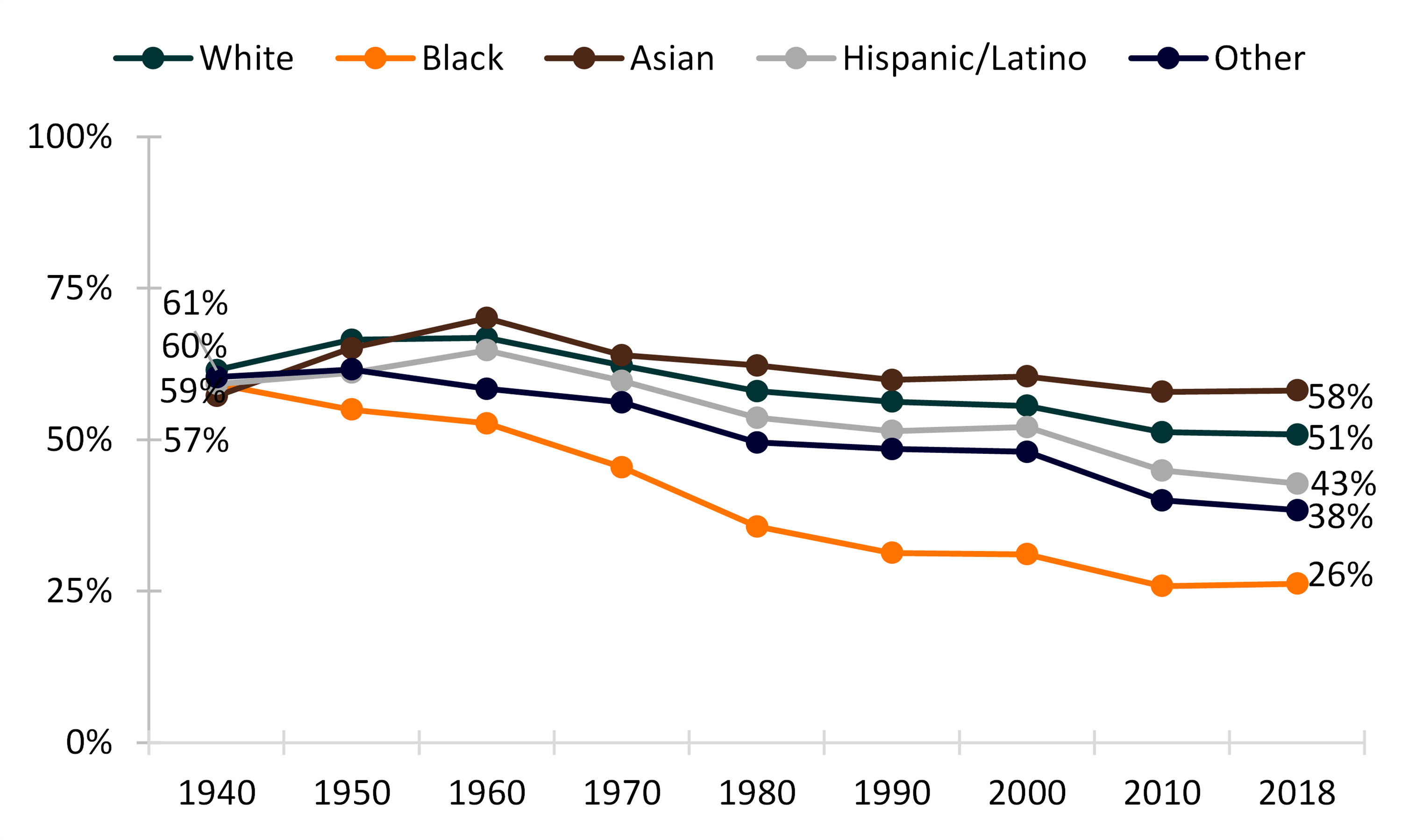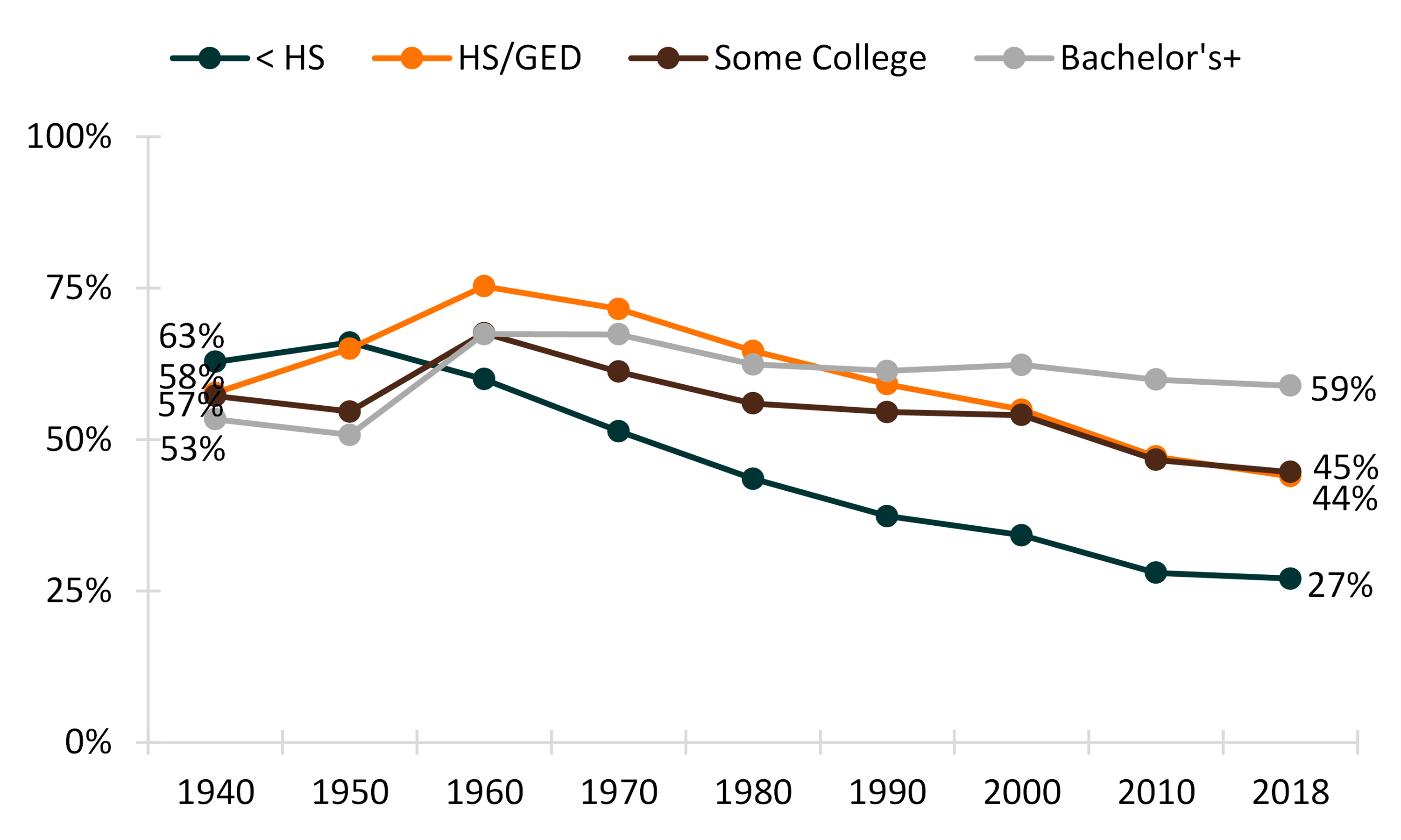Marriage: More than a Century of Change, 1900-2018
Family Profile No. 21, 2020
Author: Valerie Schweizer
Although the U.S. marriage rate has dropped dramatically over the past few decades, the rate and magnitude of the decline varies across demographic groups. Using data from the National Vital Statistics, Decennial Censuses, and the American Community Survey, this profile charts marriage patterns since 1900 for women aged 15 and older. It also includes more detailed information disaggregated by race/ethnicity and educational attainment. This profile is an update of FP-18-17 and FP-13-13.
Change in the Marriage Rate in the U.S., 1900-2018
- The marriage rate in 2018 (31.3 women married in the last year per one thousand unmarried women) had fallen by more than half compared with 1900 (68.2).
- The marriage rate peaked at 92.3 in 1920, which was nearly three times the rate in 2018.
- The marriage rate decreased steadily from 1970 to 2010 but has since stabilized.
Figure 1. Women's Marriage Rate, 1900-2018

Change in Marital Status, 1900-2018
- Since peaking at 65% in 1960, the percentage of women who were currently married (including those in a remarriage) has decreased to 46% in 2018.
- Since 1960, the share of women who were currently separated or divorced increased from about 5% to 14% in 2018. For more information on separated and divorced women, see FP-20-22 (forthcoming).
- The proportion of women who were currently widowed remained stable since 1900, with a slight decrease since 1970. For more information on widowed women, see FP-20-23 (forthcoming).
- The percentage of women who were never married was the same in 2018 as it was in 1900 (31%). It reached its lowest percentage in 1960 when only 17% of women were never married.
Figure 2. Current Marital Status of Women, 1900-2018

Variation in Percentage Currently Married According to Race and Ethnicity, 1940-2018
- In 1940, about 60% of women were married regardless of race or ethnicity.
- By 2018, the percentage of women who were currently married had declined among all racial and ethnic groups except Asian women.
- The percentage of Asian women who were married has remained the most stable since 1940. In 2018, 58% were currently married compared to 57% in 1940.
- The most dramatic drop in the share currently married was observed among Black women. In 2018, only about one-quarter (26%) of Black women reported being currently married.
- In 2018, the percentage of Hispanic and Other women who were married dropped to their lowest levels, at 43% and 38%, respectively.
- Since 1940, the percentage of White women who were married dropped ten percentage points to 51%.
Figure 3. Percentage of Women Currently Married Among Racial/Ethnic Groups, 1940-2018

Variation in Percentage Currently Married According to Educational Attainment, 1940-2018
- In 1940, between 53% and 63% of women in all educational attainment groups were married.
- By 2018, the percentages of women who were married had diverged across education groups.
- Only 27% of those with less than a high school education in 2018 were married.
- Those with a high school education and with some college education have converged in recent decades, and both continue to decline with 44% and 45% married in 2018, respectively.
- The percentages of college graduates who were married has remained steady over the last 35 years, with 59% in 2018.
Figure 4. Percentage of Women Currently Married Among Educational Attainment Groups, 1940-2018

Data Source
- Plateris, A. A. (1973). 100 Years of Marriage and Divorce Statistics United States, 1867-1967. National Center for Health Statistics. Vital and Health Statistics. Series 21: Data from the national vital statistics system. Data on natality, marriage, and divorce, no. 24; DHEW publication no. (HRA) 74-1092. Retrieved from https://stacks.cdc.gov/view/cdc/12831
- Ruggles, S., Flood, S., Goeken, R., Grover, J., Meyer, E. Pacas, J., & Sobek, M. (2020). IPUMS USA: Version 10.0 [dataset]. Minneapolis, MN: IPUMS, 2020. https://doi.org/10.18128/D010.V10.0
- Centers for Disease Control and Prevention, National Center for Health Statistics. Monthly Vital Statistics Reports. Retrieved from https://www.cdc.gov/nchs/products/mvsr.htm#43_12s
References
- Allred, C. A. (2018). Marriage: More than a century of change, 1900-2016. Family Profiles, FP-18-17. Bowling Green, OH: National Center for Family & Marriage Research. https://doi.org/10.25035/ncfmr/fp-18-17
- Carlson, L. & Schweizer, V. J. (2020). Widowhood: Decades of change. Family Profiles, FP-20-23. Bowling Green, OH: National Center for Family & Marriage Research. https://doi.org/10.25035/ncfmr/fp-20-23
- Cruz, J. (2013). Marriage: More than a century of change. Family Profiles, FP-13-13. Bowling Green, OH: National Center for Family & Marriage Research. https://www.bgsu.edu/content/dam/BGSU/college-of-arts-and-sciences/NCFMR/documents/FP/FP-13-13.pdf
- Schweizer, V. J. (2020). Divorce: More than a century of change. Family Profiles, FP-20-22. Bowling Green, OH: National Center for Family & Marriage Research. https://doi.org/10.25035/ncfmr/fp-20-22
Suggested Citation
- Schweizer, V. J. (2020). Marriage: More than a century of change. Family Profiles, FP-20-21. Bowling Green, OH: National Center for Family & Marriage Research. https://doi.org/10.25035/ncfmr/fp-20-21

This project is supported with assistance from Bowling Green State University. From 2007 to 2013, support was also provided by the U.S. Department of Health and Human Services, Office of the Assistant Secretary for Planning and Evaluation. The opinions and conclusions expressed herein are solely those of the author(s) and should not be construed as representing the opinions or policy of any agency of the state or federal government.
Updated: 04/06/2021 01:55PM

